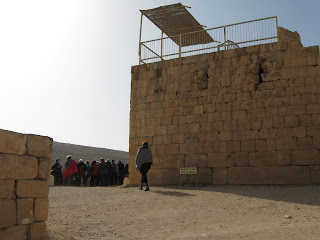The Black Hebrews, black americans originally from Chicago, believe they're the descendants of an ancient israelite tribe. They moved to Israel in 1968 (some 50 years ago) with a pitstop of over two years in Liberia, and settled in the desert city of Dimona.(some of them live in the cities of Jerusalem, Mizpe Ramon, Arad ).The spiritual, charismatic founder and leader of this movement, Ben Ammi Carter, died several years ago.
the Dimona neighborhood
We were rather late and tired when we reached the neighborhood of the Black Hebrews in Dimona. However, curiosity kept us alert and well on our feet.
conference hall
Nagila, the hostess , in an orange dress
What immediately catches the eye in this neighborhood ,is the emphasis on bright, live coloured outfits (orange, red, white, yellow, blue, pink), and the storage sheds attached to the small houses.
In addition to the orange colour (in the above photos), we saw kids playing soccer dressed in red , some other kids clothed in blue and white; the two kids in the header wore pink outfits. I rather liked that colorful display of garments. It created an optimistic atmosphere.
kids playing soccer in red clothes
blue cap /pants for the boy, white bandana; red outfit for the girl
Small, tightly spaced single story houses and an average of five children per family, naturally create crowded conditions. So, the storage sheds seem to be a Must here, and an integral part of the landscape.
house + storage shed (white fence)
storage sheds, paved passage
more storage sheds
It should be mentioned in connection to the crowded conditions, that the Black Hebrews permit polygamy and forbid birth control. (It is believed that the practice of polygamy has stopped, after a certain agreement reached with the government of Israel).
The Black Hebrews maintain a strict vegan way of life, growing much of their food, and wearing clothes made only of natural fabrics (cotton, wool, silk). We've seen a vegan restaurant, a small vegan grocery store, a vegan ice-cream shop, and some gardens with organic growths.
organic little garden
tables at the vegan restaurant
grocery store
ice-cream display case
As part of their belief in a healthy life style, the members of the community also practice exercising, and keep away from pharmaceutical or illegal drugs and alcohol. (I've noticed a facility called 'health sanctuary').
The Black Hebrews appear to be active and creative. They are engaged in crafts, and the women have a sewing studio offering sewing services to the community members.
Among other things, they have established a gospel choir which is well known both in Israel and in the USA.
The Black Hebrews appear to be active and creative. They are engaged in crafts, and the women have a sewing studio offering sewing services to the community members.
Among other things, they have established a gospel choir which is well known both in Israel and in the USA.
Although they don't see themselves as belonging to any particular religion , they do observe major religious traditions and customs that are biblical (Sabbath, Yom Kippur, Passover...), and express their intent to live according to the laws and prophecies of God.
I remember reading in some article that the late Ben Ammi Carter stated in an interview that there will never be peace in the world by way of.politicians. How true!.
It was a short visit but quite enlightening.





































